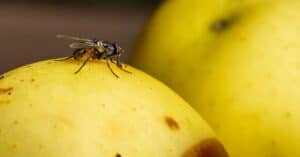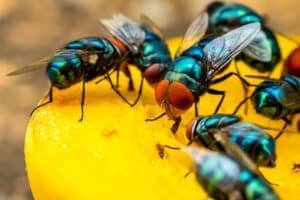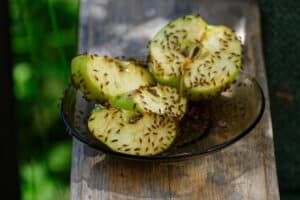
It may seem that flies live all summer long, pestering humans in their homes, on their patios, and during a lovely picnic lunch. But how long do flies live?
These insects have a shorter lifespan than you may think. Flies are any small, winged insects in the order Diptera which has over 120,000 species. The most common fly is the housefly, representing 90% of the fly encounters in human homes.
Other flies you may be familiar with are the horse fly, fruit fly, and tsetse fly. Two other flying insects that you may not have known are also in the Diptera order are the gnat and mosquito. Given the wide variety of flies out there, the question is worth exploring–how long do flies live?
Let’s take a look at these flies to learn all about their lifespans.
Housefly: Lifespan 28-30 days

The housefly has spread all over the world as a commensal of humans. It is the most common fly species found in houses.
©Fotopstryk/Shutterstock.com
Houseflies are the most common type of fly and can be recognized by their two wings, six legs, big reddish-brown eyes, and stripes on their thorax. Houseflies are about the size of a fingernail with the females being a bit larger than the males.
They live in our homes and can be bothersome flying around our heads and trying to land on our food, but they do not bite. They can carry diseases by spreading contaminated microorganisms.
For example, if they land on a pile of decaying garbage, pick up microorganisms on their feet, and then land on your corn on the cob you could potentially be exposed to the same thing, and if in large quantities could make you sick. The lifecycle of flies is similar in most species.
They go through 4 cycles as follows:
- Egg Stage: Females lay around 100 eggs at a time and they hatch in 12-24 hours
- Larvae (maggot) Stage: Maggots are small, white, and worm-like. During this feeding stage, the larvae will grow to ¾ inches or more. This stage can take 4-7 days.
- Pupae Stage: In the pupae stage the fly looks like a dark brown cocoon and it will develop in this stage for 4-6 days.
- Adult Stage: After the pupae stage the adult fly emerges and can expect to live up to 28-30 days. The females are ready to lay eggs of their own an average of 12 days after reaching maturity.
The life cycle of the fly is repeated generation after generation with a female fly laying 5-6 batches of eggs in her lifetime.
Horse fly: Lifespan 30-60 days
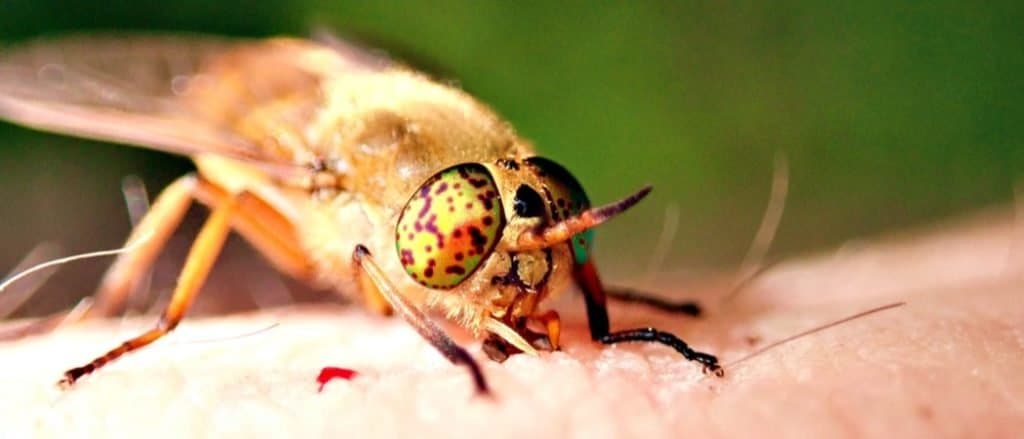
Horsefly
with Spectacular Eyes Feeding on human.
©JumpingSpiderss/Shutterstock.com
Horse flies are similar to house flies in that they have a similar lifespan. They are larger than houseflies and can grow to be the size of a bumblebee. They get their name from being common around stables and bothering horses in the fields and they don’t just bother them, they bite them. Horse flies are bloodsuckers and use the protein from the blood for their fertilized eggs.
They will bite humans as well. Although the bites are not harmful, they do hurt and can cause itchiness afterward. The bite of the horse fly can be dangerous to horses because they carry “equine infectious anemia” which can cause fever and illness in horses. Farmers and ranchers often cover their horses with a heavy blanket to help deter horse flies from biting.
Horse flies have a very different life cycle than house flies. They lay eggs on the grass in the fall and then the eggs hatch and turn into larvae over the winter. In the spring the horse fly develops into the pupae stage and by early June it emerges as an adult. The adult horse fly can expect to live 30-60 days.
Fruit fly: Lifespan 40-50 days
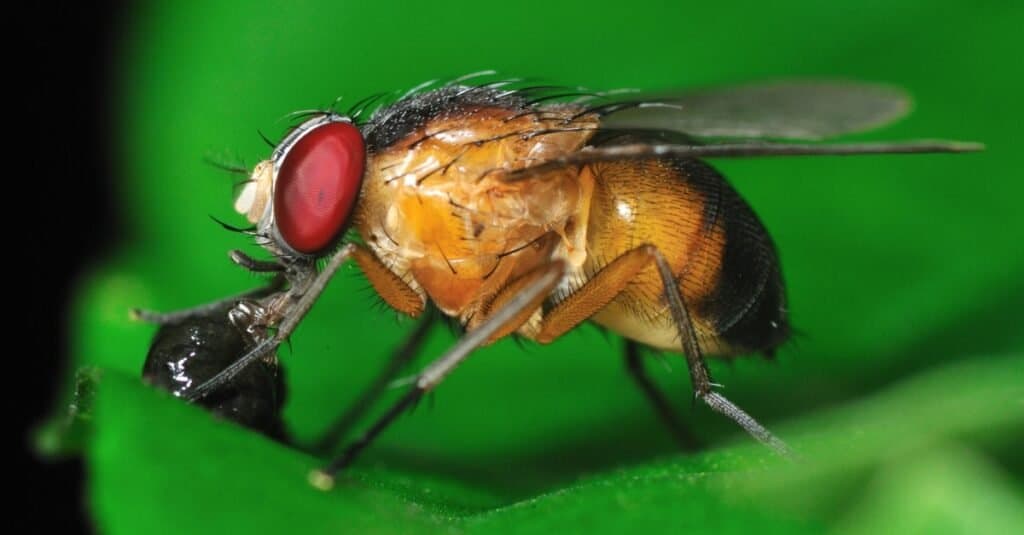
In most cases, fruit flies should be considered beneficial insects. The decaying matter they eat might otherwise turn into a source of a fungal or bacterial infection or attract more undesirable pests, such as mice or rats.
©Jordan Lye/Shutterstock.com
Fruit flies are the tiny flies you may see around the fruit bowl on your counter, especially if you have ripe bananas. These little flies can reproduce quickly! Their lifespan includes the egg, larvae, pupae, and adult stages as well but each stage is only a few days long and they can go from an egg to an adult in as little as a week. Once they are adults they can live for 40-50 days
Tsetse fly: Lifespan 14-21 days (males); 1-4 months (females)

Tsetse flies are found in
Africa
, living in damp areas along the banks of rivers and lakes. They are the size of a large housefly and feed only on blood.
©Jaco Visser/Shutterstock.com
Tsetse flies are not an issue in North America because they can only be found in Africa. The female tsetse fly has one of the longest lifespans of flies, living from 1-4 months. Tsetse flies are a huge problem in Africa because they carry a disease called sleeping sickness. It is fatal if left untreated however medications are available that can cure it, but tsetses attack livestock and other animals as well, leaving those animals with a fatal end. Tsetse flies have one of the most unique lifecycles. The female tsetse fly has a uterus where she carries the larvae. The larvae grow inside the female for around 9 days and then when it is birthed it burrows into the ground to complete the pupae stage. It will spend 3 weeks to a month in the pupae stage before emerging as an adult. The adult males have a short lifespan of 14-21 days and the females go on to live from 30-120 days.
Gnat: Lifespan 7-14 days
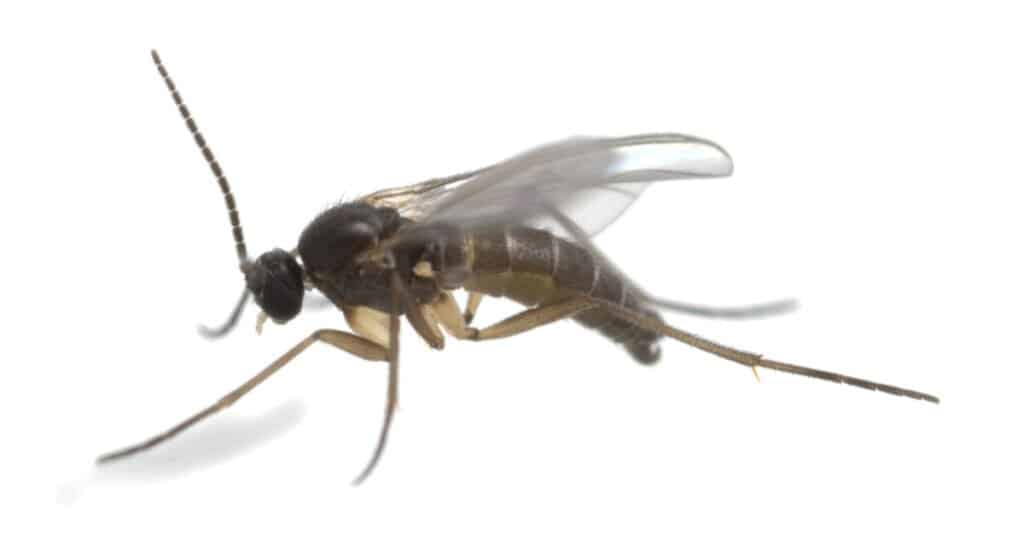
Gnats only live up to two weeks
©Henrik Larsson/Shutterstock.com
Gnats are the annoying little bugs that fly around your face at the bus stop. They are not baby flies as some have thought. They are their own species and have similarities to the housefly. Gnats as a group have one of the shortest lifespans with some only living a week.
The fungus gnat is commonly found in house plants or can be found in the lobby of commercial buildings by indoor plants. As their name suggests they feed off the fungus that is present when these plants are overwatered. Gnats follow a similar life cycle as the fruit fly with it lasting anywhere from a week to two weeks. Similarly, adult gnats live from 7-14 days.
Mosquito: Lifespan 10-14 days (depending on the temperature)

Mosquitoes are the world’s deadliest animals because of all the deadly diseases that they spread.
©iStock.com/nechaev-kon
Mosquitos are flies! They are frequent summer pests that have long slender legs so they can land on you without you noticing. Only the females bite, but the resulting bite can produce an itching sore for days to come. This is the most common outcome of a bite, but they can carry diseases like the Zika virus, West Nile and malaria. According to the CDC, “…most people infected with WNV do not feel sick. About 1 in 5 people who are infected develop a fever and other symptoms.”
Mosquitos have a similar life cycle as houseflies but the eggs must be laid in stagnant water. The eggs hatch in the water and the larvae are aquatic, meaning they live in the water until they reach the pupae stage. It spends a few days in the pupae stage and the adult emerges ready to fly. Adult mosquitos live longer in cooler temperatures (14 days) and they live shorter in warmer temps (10-days).
So how long do flies live? As you can see from our analysis, not very long. The horsefly has the longest lifespan with a maximum of 60 days. The peskiest of species to humans, the common housefly, lives up to one month. But flies can certainly wreak a lot of havoc in that timespan, when you take into account that a multitude of flies grouped together, with varying ages between them, can mean months upon months of annoyance!
The photo featured at the top of this post is © Fotopstryk/Shutterstock.com
Thank you for reading! Have some feedback for us? Contact the AZ Animals editorial team.



